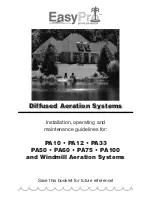
Difficulty
Probable Cause
Remedy
Product viscosity too high.
Lower viscosity by increasing product
temperature or dilution. Increase
pump and/or piping size.
Product cavitating.
Increase suction pressure.
Delivery gradually
drops.
Check valve leakage.
Clean, replace if damaged.
Leak in suction line.
Locate and correct.
Strainer fouled.
Clean or replace screen.
Product change.
Check viscosity and other variables.
Supply tank vent plugged.
Unplug vent.
Delivery erratic.
Leak in suction line.
Locate and correct.
Product cavitating.
Increase suction pressure.
Entrained air or gas in product.
Consult factory for suggested venting.
Motor speed erratic.
Check voltage and frequency.
Fouled check valves.
Clean, replace if necessary.
Inadequate backpressure
Increase discharge pressure to obtain
a minimum pressure difference of 5
psi from suction to discharge.
Delivery higher than
rated.
Suction pressure higher than
discharge pressure.
Install backpressure valve or consult
factory for piping recommendations.
Back pressure valve set too low.
Increase setting.
Back pressure valve leaks.
Repair, clean, or replace.
Noisy gearing,
knocking
Discharge pressure too high.
Reduce pressure.
Water hammer.
Install pulsation dampener.
Stroke length at partial setting.
Some operating noise is characteristic
of lost motion pumps.
Low grease level.
Add or replace grease.
Piping noisy.
Pipe size too small.
Increase size of piping - install
pulsation dampener.
Pipe runs too long.
Install pulsation dampener in line.
Pulsation dampener inoperative
or flooded.
Refill with air or inert gas. Inspect and
replace diaphragm and recharge.
No surge chamber or dampener
used.
Install pulsation dampeners.
Motor overheats.
Pump overloaded.
Check operating conditions against
pump design. Verify discharge
pressure.
High or low voltage.
Check power source.
Loose wire.
Trace and correct.
Incorrect motor wiring.
Verify and correct.
7. Piping Accessories
Pressure Relief Valves
Pressure relief valves are designed to protect chemical feed systems from damage that
may be caused by defective equipment or a blockage in the discharge line. These valves
function to limit the pressure downstream of the pump. Field adjust the pressure relief
valve to operate when the discharge pressure exceeds operating pressure by 10-15%.
Pressure relief valve should always be adjusted to a setting below the maximum rated
pressure of the pump. No potentially restrictive components, such as a valve, should be
installed between the pump discharge and the PRV.
Diaphragm Backpressure Valve
17






































